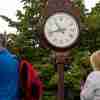
You can watch a parade of planets in the morning sky — if you get up really early
CBC
Early risers take note: Something beautiful has been happening in the east in the wee hours of the morning, and it's about to get even better.
Over the past month, four planets — Saturn, Mars, Venus and Jupiter — have been marching upwards from the eastern horizon.
But two are ready for a super-close match-up. On Saturday and Sunday morning, Venus and Jupiter will appear almost inseparable. They will be separated by less than half the width of a full moon.
These kinds of meetings — where two celestial bodies appear extremely close together in the sky — are called conjunctions.
Of course, the pair are actually separated by some 650 million kilometres. Their orbits just have them crossing in the same patch of sky.
If you want to stumble out of bed and take a look, the best time is before sunrise, around 5 to 5:30 a.m. local time. And you'll need to have a good view of the eastern horizon.
You'll find two extremely bright "stars" closest to the horizon. Those are Jupiter and Venus.
The two will be less than a degree apart — 0.2 degrees, to be precise — on both April 30 and May 1.
Then, moving diagonally upwards to your right, you'll spot a faint reddish object: Mars.
And finally moving in the same direction, you'll see Saturn.
If you'd like to see the conjunction better, you can use a pair of binoculars. Just be sure that you put them away before the sun comes up. You don't want to risk damaging your eyes.
After this conjunction the pair will begin to move farther apart in the sky.
The great thing about this conjunction is that it occurs between two of the brightest planets in our sky. Venus is the brightest and is often called either a "morning star" or an "evening star," depending on where it is in the sky at the time of day. It has sometimes been mistaken for a plane or, yes, even a UFO.
Jupiter is the second-brightest planet in the sky, and is hard to miss.

Health Minister Adriana LaGrange is alleging the former CEO of Alberta Health Services was unwilling and unable to implement the government's plan to break up the health authority, became "infatuated" with her internal investigation into private surgical contracts and made "incendiary and inaccurate allegations about political intrigue and impropriety" before she was fired in January.












